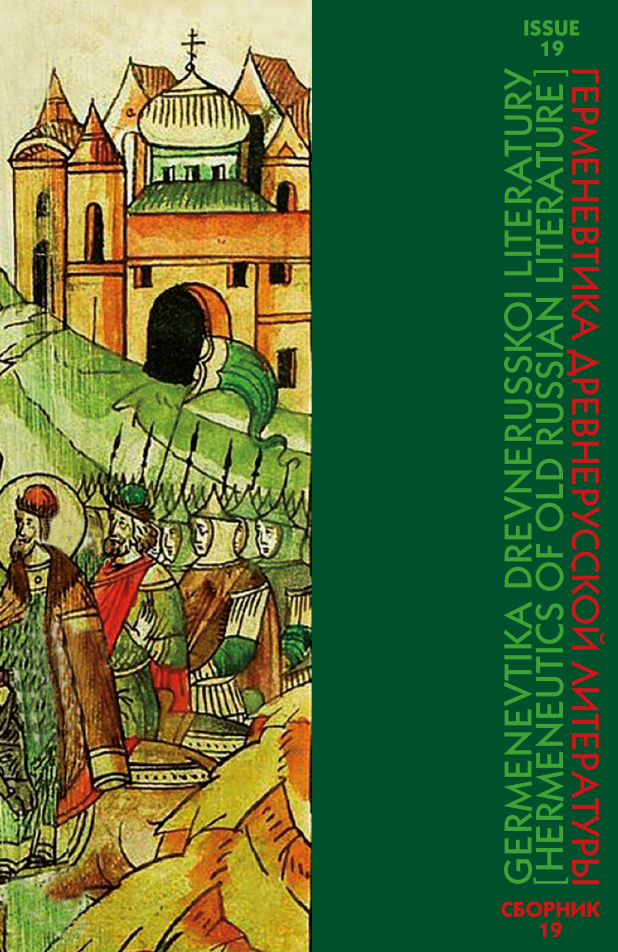Abstract:
The article examines Russian rulers’ portrayals in the Mazurinsky Chronicle. The events reflected in the Mazurinsky Chronicle cover the period from legendary rulers of Slavs to Peter I. By the end of the 17th century there was an extensive tradition of depicting Russian princes in the chronicles from old times, in the lives (vitas), in the military narration, The Book of Degrees of the Royal Genealogy, and in the publicistic works of Time of Troubles. Isidor Snazin is the author of the Mazurinsky Chronicle who used the possibilities of all these genres. The presentation of Russian history as a God-patronized state required selection of facts and construction of a certain system of the rulers’ images. Pagan rulers are depicted, often with the help of hyperboles, on the basis of chronicles as powerful warriors who fought successful battles against the enemies and glorified by force, although in comparison with the stories of the Tale of Bygone Years, information about them is significantly reduced. Form this circle of rulers, only Rurik, briefly mentioned by Snazin, later appears as the ancestor of the Russian princes. To reflect the main milestones in the history of the Moscow state, the chronicler used images of Moscow rulers and their direct ancestors, presented in detail in The Book of Degrees of the Royal Genealogy, the creators of which depicted them as ideal characters. A significant part of the images in the chronicle of Snazin is also idealized, by depicting in the actions, evaluation by other characters, in praising characteristics created by techniques of an emotionally expressive style. According to the chronicle tradition, together with ideal characters, rulers appear depicted in a real-historical way, showing diverse qualities depending on the course of events. The princes, contemporaries of the heroes of The Book of Degrees of the Royal Genealogy, are depicted in detail when the life (vita) of saints, portents and wonders are connected with their rule. In the characteristics of the kings of the 17th century the documentaryceremonial style appeared, which was not used in the previous narrative, and emotional characteristics were weakened.
REFERENCES
1 Azbelev, S.N. “Novgorodskie mestnye letopistsy” [“Novgorod Local Chronicles”]. Trudy Otdela drevnerusskoi literatury [Proceedings of the Department of Old Russian Literature], vol. 15: For the Fourth International Congress of Slavists, resp. ed. D.S. Likhachev. Moscow, Leningrad, Nauka Publ., 1958, pp. 364–370. (In Russian)
2 Bogdanov, A.P. Letopisets i istorik kontsa XVII veka: Ocherki istoricheskoi mysli “perekhodnogo vremeni” [Chronicler and Historian of the End of the 17th Century: Essays on the Historical Thought of the “Transitory Time”]. 2nd ed., rev. and exp. Moscow, Berlin, Direkt-Media Publ., 2019. 218 p. DOI: 10.23681/495856 (In Russian)
3 Lobakova, I.A. “‘Povest’ o razorenii Riazani Batyem’ v sostave letopisnykh svodov XVII v.” [“The Tale of the Destruction of Ryiazan by Batu in the Seventeenth Century Chronicle Compilations”]. Trudy Otdela drevnerusskoi literatury [Proceedings of the Department of Old Russian Literature], vol. 69, resp. ed. S.A. Semyachko. St. Petersburg, Pushkinskii Dom Publ., 2022, pp. 469–494. DOI: 10.31860/0130-464X-2022-69-469-494 (In Russian)
4 Trofimova, N.V. “Voinskoe povestvovanie v ‘Mazurinskom letopistse’.” [“The Military Narration in ‘Mazurinsky Chronicle’.”]. Vestnik Riazanskogo gosudarstvennogo universiteta imeni S.A. Esenina, no. 4 (77), 2022, pp. 83–93. DOI: 10.37724/RSU.2022.77.4.009 (In Russian)
5 Trofimova, N.V. “‘I byst’ tsar’ slaven.’ Izobrazhenie Ivana Groznogo v ‘Mazurinskom letopistse’.” [“‘And He Was a Glorious King.’ The Image of Ivan the Terrible in the ‘Mazurinsky Chronicle’.”]. Germenevtika drevnerusskoi literatury [Hermeneutics of Old Russian Literature]. Issue 22. Ed.-in-chief O.A. Tufanova. Moscow, IWL RAS Publ., 2023, pp. 455–466 https://doi.org/10.22455/HORL.1607-6192-2023-22- 455-466 (In Russian)






